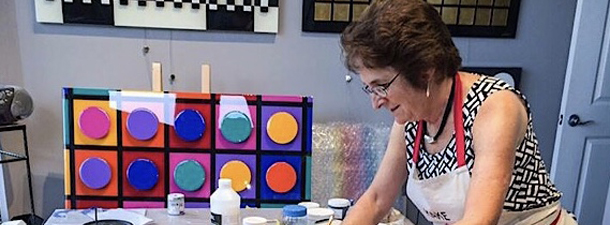Fusing Art and Design: ‘Bentel & Bentel Architects’ Partner Carol Bentel Discusses Her Company and More

Carol Rusche Bentel, Ph.D., is a college professor and architect who was a Fulbright Scholar at the University of Venice, Italy, and is a Fellow of the American Academy in Rome. Carol has taught and delivered lectures at Harvard, MIT, Yale, the Architectural Association in London, and the Centro Palladio in Vicenza. She has also published numerous articles on Italian Modernism and served as the national chair of the AIA Committee on Design with over 10,000 members.
Carol is a partner in the studio of Bentel & Bentel, Architects/Planners AIA–a company founded by her husband’s family–and a licensed architect. She recently discussed her career and the Long Island based firm of Bentel and Bentel–which recently had a successful showing at the ICFF furniture convention–in an exclusive interview:
Meagan Meehan (MM) of Entertainment Vine: When did you first get interested in design and how did you break into the industry and establish your company?
Carol Bentel (CB): While a student in an all-girl high school in Missouri, I took a career survey test. It said that I should be an accountant or a florist. On the male side of the test, it said that I should be an architect. I then applied to the only school in Missouri with an architecture school – Washington University in St. Louis.
Our company, Bentel & Bentel Architects, was established by Maria Bentel FAIA and Dr. Frederick Bentel FAIA, both deceased. Their sons, Dr. Paul Bentel FAIA and Peter Bentel AIA, became architects and have carried on the practice. I met Paul (my husband) while working at The Architects Collaborative in Cambridge. He was completing his last year of architecture school at the GSD at Harvard. We are all three partners in the firm.
MM: Your designs are beautiful and abstract so how inspired are you by fine art?
 CB: The designs that you saw at the ICFF show (stools and rug design) have evolved out of our work in Interior Design. We are all architects, but do a great deal of work in the hospitality realm (restaurants/hotels), thus much of our work is inside buildings. I should note that we also do buildings! We have designed many restaurants, such as The Modern at MoMA and Le Bernardin and have won three James Beard Awards for restaurant design. We like to design as much as we can in our spaces, so we design our own furniture and rugs for these spaces when possible.
CB: The designs that you saw at the ICFF show (stools and rug design) have evolved out of our work in Interior Design. We are all architects, but do a great deal of work in the hospitality realm (restaurants/hotels), thus much of our work is inside buildings. I should note that we also do buildings! We have designed many restaurants, such as The Modern at MoMA and Le Bernardin and have won three James Beard Awards for restaurant design. We like to design as much as we can in our spaces, so we design our own furniture and rugs for these spaces when possible.
We prefer modern design, abstract forms over representational ones, asymmetry over symmetry. Authentic materials are important to us: polished stainless steel, leather, and wool (with respect to the products we exhibited at ICFF). The same can be said about our interiors, which I can elaborate on if needed.
Our design focus has also grown out of our firm’s heritage as Maria and Fred were modernists who trained at MIT. Before becoming architects Paul studied sculpture and printmaking, Peter studied painting and sculpture, and I studied dance (modern and classical ballet) – this “artistic” background does feed our work!
MM: How many designers have provided concepts to the company and how do you choose which ones to market?
CB: We provide the concepts for all of our projects. The items we decided to market (our first time at ICFF) are stools and rugs that we think might be of interest to other designers.
MM: How long does it typically take to design one of your rugs and what has consumer response been like?
CB: We have designed many carpets, but the rug you saw at ICFF was our first singular rug. Paul Bentel was a print maker at the Carpenter Center before studying architecture and has continued to create the colors and shapes that we have now made into rugs. We received a very positive reaction at ICFF.
MM: Aside from rugs, do you design any other objects?
CB: We design many items from tables to buildings. I should note that the next generation of Bentels (Lukas, Michela & Nikolas) are also designers and two are industrial designers. The scrap stool that you saw at the ICFF show is by Nikolas Bentel (23) and the drip stool was designed by Lukas Bentel (25).
MM: That’s so cool! What are some of your kid’s endeavors?
CB: Lukas has found some success working with online media. He launched several web pieces with his artist group that “went viral” and were covered by all sorts of national and international press. The first was Bitelabs.org – a startup looking to grow invitro celebrity salami. Trying to repeat the success of Bitelabs he followed up with a few additional projects most notably The McMass Project – a crowdfunding campaign looking to raise $1 Million Dollars to buy a McDonald’s franchise and donate it to a church with a diminishing congregation. Both semi-satirical in nature, these projects started some very interesting real discussion in the news and on social media. He has since parlayed some of the success of Bitelabs and McMass into building a digital creative studio call Hello Velocity. For the past year and a half, he has been a resident at New Inc – the New Museum’s art + tech incubator for artists/business that work between art, tech and commerce. He is also actively working on several music projects and has had some additional media success with his group Ohm + Sport when he launched a spotify webapp called Eternify that let users stream spotify tracks in 30 second increments endlessly, to maximize royalties for smaller music groups that couldn’t viably compete in the streaming economy.
Nikolas is an artist, designer, and performance artist, who will be starting as a resident at New Inc. in September. He graduated from the Brown-RISD Dual Degree Program in Industrial Design (RISD) and the Modern Media and Culture Program (Brown University).
Michela Bentel is still in college in the Brown-RISD Dual Degree Program. She has a special interest in the culinary world and designs industrial design products for food. Last year she worked in Alice Waters’ kitchen at the American Academy in Rome as an intern. She will graduate next year, since she took time to work in Rome. Michela’s sculpture has been shown at MoMA under the YoungArts program. Michela’s steel forest (which lights up at night because it is solar powered) won her a commission for more “nature” towers in Florida.
MM: You recently completed your Ph.D., what did you focus your dissertation on and what was it like to work on such an advanced degree?
CB: My dissertation topic was focused on a study of a building called the “casa del fascio,” which was built by the Fascist regime during the period between WWI and WWII in Italy. The Fascist Party had planned over 11,000 of these buildings throughout Italy and their territories. Working on an advanced degree was a dream – what could be better than diving into a topic in a thorough manner, unearthing fresh material, and making some unique discoveries? Nothing I found was earth-shattering, but I believe I added to the scholarly material on the subject. The dissertation research and writing is one major aspect of getting a PhD, but the academic work that precedes the dissertation is worth every second. I had the opportunity to study with some of the best scholars in this country and in Italy. I was also given teaching opportunities to hone my teaching skills at MIT and Harvard during my years as a doctoral student, which was a priceless experience.
MM: You have taught in colleges for years, so which courses did you enjoy most and what were some of the most memorable interactions with students?
 CB: I teach in several realms, because I have a background in a few different areas such as design and modern architectural history. First, I have taught architectural design and interior design, which I enjoy because this is what I do every day in my own office. I like teaching second year students because they are still risk takers and are not yet encumbered with the realities of building. I like teaching graduate thesis studios because each project is unique and being done at a high level. Second, I can also teach architectural history. I currently teach at Webb Institute on Long Island and teach naval architecture students, who design ships. Teaching non-architecture students could be a challenge, although I find the students eager to learn about the topic since it is different from the rest of their classes and I think that it adds an understanding of aesthetics and social/political reasons for making design decisions to their knowledge base. I have also taught in a Hospitality Management program (NYCCT- CUNY). This was very exciting since the students were similar to our clients – they were studying to become chefs, restaurateurs, hotel staff…I took them all over the city to see hospitality projects under construction and then I put them in my shoes – they had to design a restaurant. I have attached an article from Hospitality Design Magazine that came from one of these classes.
CB: I teach in several realms, because I have a background in a few different areas such as design and modern architectural history. First, I have taught architectural design and interior design, which I enjoy because this is what I do every day in my own office. I like teaching second year students because they are still risk takers and are not yet encumbered with the realities of building. I like teaching graduate thesis studios because each project is unique and being done at a high level. Second, I can also teach architectural history. I currently teach at Webb Institute on Long Island and teach naval architecture students, who design ships. Teaching non-architecture students could be a challenge, although I find the students eager to learn about the topic since it is different from the rest of their classes and I think that it adds an understanding of aesthetics and social/political reasons for making design decisions to their knowledge base. I have also taught in a Hospitality Management program (NYCCT- CUNY). This was very exciting since the students were similar to our clients – they were studying to become chefs, restaurateurs, hotel staff…I took them all over the city to see hospitality projects under construction and then I put them in my shoes – they had to design a restaurant. I have attached an article from Hospitality Design Magazine that came from one of these classes.
MM: You are writing a book about architecture, what was that process like?
CB: Our book is about the architecture of restaurant design. The process took almost three years, but it is our first book and helped us to compile our material in one location with an overriding thread that speaks to our specific design attitude – authentic materials, enduring architecture, make an institution, no bad seats…The process also showed me the importance of visual material like photographs and the need to properly document projects as soon as they are complete.
MM: Did you have trouble finding publishers?
CB: Our book on restaurant design is a “vanity press.” They found us. John Morris Dixon, who is the editor, reached out to me, which was an honor since John is quite well regarded in the field. We have not yet sought a publisher for the “Raising Artists” book, nor for my dissertation subject.
MM: You’re also writing a book about raising artists so how did that come about and what subjects will it cover?
 CB: Soon after all three children were in college we did not experience a surplus of time as many empty-nesters do, since our office kept us very busy, but there was a lack of a non-work-related activity of passion. Our children were our passion when they were present. Time was at a minimum to do anything but maintain our office and child-rear during that period because of our own way of “home-schooling” (despite the children being in schools), which made most every minute a scheduled one. And their many activities also required a parent or at least a chauffeur, so there was no time left over. After the three all left for college we realized that we had made an early decision to bring the children up in an unconventional way, and thought we should write it down, before our memories faded of the marvelous flurry of the twenty previous years.
CB: Soon after all three children were in college we did not experience a surplus of time as many empty-nesters do, since our office kept us very busy, but there was a lack of a non-work-related activity of passion. Our children were our passion when they were present. Time was at a minimum to do anything but maintain our office and child-rear during that period because of our own way of “home-schooling” (despite the children being in schools), which made most every minute a scheduled one. And their many activities also required a parent or at least a chauffeur, so there was no time left over. After the three all left for college we realized that we had made an early decision to bring the children up in an unconventional way, and thought we should write it down, before our memories faded of the marvelous flurry of the twenty previous years.
In addition, the impetus for the book came from a group of professional women friends with whom I met occasionally. One suggested that I read Amy Chua’s book “The Battle Hymn of a Tiger Mother” because she knew I did not allow play dates or television. After reading the book I was riled by the true role that art played in the lives of Ms. Chua’s two children, more than the strictness that had appalled so many other readers. Art training, music in this case, for the Chua children was a ticket to get into a prestigious college, rather than even considering a life in the arts on its own. I do know many doctors and lawyers who play music seriously, so I hope that I am mistaken about the Chua children and that the training was to gain a beautiful life skill, despite one’s chosen profession.
A profession in the arts is often demeaned and considered second rate. This attitude made me want to make a case for children who have the aptitude for math, science and professions outside of the arts, who make a conscious decision to be in the arts. Making this decision does not mean that they could not succeed in a “more difficult” profession, as many consider other professions to be. The arts are “difficult” and I would propose that the equation should be reversed.
The unpublished book “Raising Artists” is intended as a platform for discussion about parenting and educating children. The proposal implores the reader to consider a separate, off-the-grid childhood experience with a focus on the arts. Based on our experiences as educators, the model of the “artist” correlated with the academic and professional success in our own students. The differentiation of our good students from our great students was not by intellect or an ability to perform well on tests but rather creativity, ambition and competency in the making of things – whether it be writing, drawing, model-making or computer code writing.
Cultivating the personality traits of an artist allows children to reflect on their own inner thoughts and goals which can spur them toward intellectual and emotional growth. This observation proved convincing across gender, ethnic, social and cultural boundaries.
MM: What events and/or projects are forthcoming and is there anything else that you want to mention or discuss?
CB: We have several events coming up! Our new book is currently being printed and I officially received my PhD (after 29 years) in February of this year!
* * * * *
To learn more about Carol, visit the official website of Bentel and Bentel.



